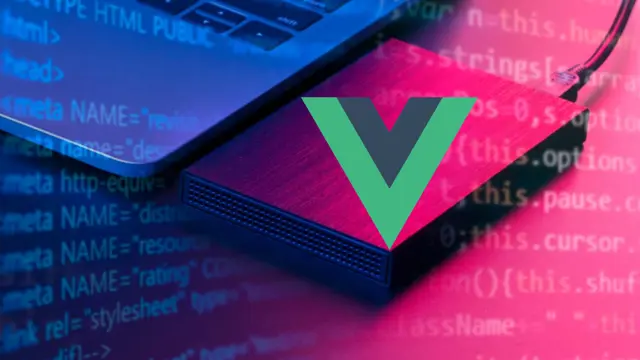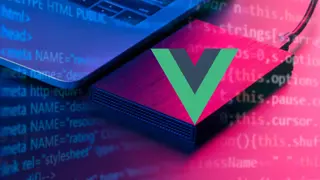
Vue.js: Unleash the Power of Reactive Web Development
Self-paced videos, Lifetime access, Study material, Certification prep, Technical support, Course Completion Certificate
Uplatz
Summary
- Reed Courses Certificate of Completion - Free
- Uplatz Certificate of Completion - Free
Add to basket or enquire
Overview
Uplatz provides this comprehensive course on Vue.js: Unleash the Power of Reactive Web Development. It is a self-paced course with pre-recorded video tutorials. You will be awarded Course Completion Certificate at the end of the course.
Vue.js (pronounced "view") is a popular JavaScript framework for building user interfaces and single-page applications. It's designed to be approachable, versatile, and performant. Vue.js provides a structured and efficient way to build dynamic user interfaces by combining a template-based syntax, a reactive data binding system, and a component-based architecture. This makes it a popular choice for both small projects and large-scale applications.
What is Vue.js?
- Progressive Framework: Vue.js can be adopted incrementally. You can use it to add interactivity to existing static HTML or build complex applications from scratch.
- Focus on the View Layer: Vue.js primarily deals with the user interface (the "view") of your application, making it easy to integrate with existing projects or other libraries.
- Component-Based: Vue.js allows you to break down your UI into reusable components, each with its own template, logic, and style. This promotes code organization and reusability.
- Reactive Data Binding: Vue.js automatically updates the UI when the underlying data changes, and vice versa. This makes it easy to create dynamic and interactive applications.
How Vue.js Works
- Templates: Vue.js uses HTML-based templates to define the structure of your UI. These templates can include special Vue.js directives (e.g., v-if, v-for) to dynamically control what's displayed.
- Reactivity System: At the core of Vue.js is a reactivity system. When you change data in a Vue.js component, the framework automatically tracks these changes and efficiently updates the parts of the UI that depend on that data.
- Virtual DOM: Vue.js uses a virtual DOM to optimize updates. Instead of directly manipulating the real DOM (which can be slow), Vue.js first updates a lightweight copy (the virtual DOM) and then compares it to the real DOM to determine the most efficient way to apply the changes.
- Components: Vue.js components are reusable building blocks for your UI. Each component encapsulates its own template, logic, and styles, making it easy to manage and maintain complex applications.
- Data Binding: Vue.js provides a simple and intuitive way to bind data to your templates. You can use directives like v-model to create two-way data binding, keeping your UI and data in sync.
Certificates
Reed Courses Certificate of Completion
Digital certificate - Included
Will be downloadable when all lectures have been completed.
Uplatz Certificate of Completion
Digital certificate - Included
Course Completion Certificate by Uplatz
Curriculum
Course media
Description
Vue JS - Course Syllabus
Module 1: Introduction to Vue.js
What is Vue.js – Overview and benefits of using Vue.js.
Setting up Vue 3 with CDN – Quick setup for small Vue 3 applications.
Module 2: Setting Up a Vue Project
Creating a Vue 3 Project with Vite – Project setup and live code reloading with Vite.
Vue 3 + Vite Project Structure – Understanding the project structure.
Module 3: Core Vue Concepts
Components, Data, and Methods – Building a basic app to explain these concepts.
Directives, Data Binding, and Event Handling – Examples of directives, data binding, and events.
Module 4: Advanced Reactivity in Vue
Computed Properties and Watchers – Different types with practical examples.
Vue Props – Passing data and events between components.
Class and Style Bindings – Using object and array syntax.
Conditional and Iterative Rendering – Using v-if, v-else, v-show, and v-for directives.
Module 5: Handling Events and Forms
Event Handling and Modifiers – Listening to events and using key modifiers.
Form Controls – Working with form inputs in Vue.
Form Modifiers and Validation – Using .lazy, .number, .trim, and form validation.
Module 6: Component Communication
Child-to-Parent Communication – Using $emit and v-model.
Compilation Scope – Using props, events, and slots for component scope management.
Module 7: Slots and Dynamic Components
Single, Named, and Scoped Slots – Using slots with examples.
Dynamic Components – Switching components with keep-alive and lazy loading.
Module 8: Lifecycle and Custom Directives
Lifecycle Hooks – Practical uses of lifecycle hooks.
Custom Directives – Creating custom directives with hooks and arguments.
Module 9: State Management with Pinia
Introduction to Pinia – Lightweight state management.
Advanced Pinia Usage – Actions, getters, modular stores, and persisting state.
Module 10: API and HTTP Requests
Using Fetch API and Axios – Making GET/POST requests with error handling.
Module 11: Routing with Vue Router
Vue Router Basics – Routing setup and configuration.
Styling and Imperative Navigation – Styling active links and using router.push() and router.go().
Module 12: Composition API
Introduction to Composition API – Core concepts and usage.
In-Depth Composition API – Advanced usage and integration with Pinia.
Module 13: Animations and Transitions
Transitions and Animations – Using <transition> and <transition-group>.
Module 14: Testing and Optimization
Testing with Vitest – Basic and advanced testing with snapshots and mock API.
Vue 3 Optimization – Techniques for optimizing Vue applications.
Module 15: Styling with Tailwind CSS
Vue with Tailwind CSS – Basics of using Tailwind with Vue.
Vue and Tailwind Project – Building a task manager with data persistence.
Module 16: Progressive Web Apps (PWA)
Introduction to PWA – Fundamentals of Progressive Web Apps.
Building a Vue PWA with Vite – Setting up a PWA with caching strategies.
Module 17: Integrating Firebase
Vue with Firebase – Setting up Firebase for authentication and data management.
Building a Project with Pinia and Firebase – A full Vue project integrating Pinia and Firebase.
Module 18: Production and Deployment
Vue 3 Production and Deployment – Preparing and deploying Vue applications.
Module 19: Interview Preparation
Common Vue.js Interview Questions – Key questions and answers for Vue-related roles.
Benefits of learning Vue.js
Learning Vue.js offers numerous benefits for aspiring and seasoned developers alike. By learning Vue.js, you gain a valuable toolset for building modern, dynamic, and efficient web applications, opening doors to exciting career opportunities and enhancing your development capabilities. Some key advantages of learning Vue are:
1. Ease of Learning and Use
- Gentle Learning Curve: Vue.js is known for its beginner-friendly syntax and clear documentation, making it easier to learn compared to other frameworks like Angular or React.
- Simple Integration: You can easily integrate Vue.js into existing projects or use it to build single-page applications from scratch.
- Intuitive API: Vue.js has a well-defined and easy-to-understand API, allowing developers to quickly grasp its core concepts and start building applications.
2. Enhanced Productivity and Performance
- Faster Development: Vue.js streamlines development with its component-based architecture, reusable components, and efficient rendering system.
- High Performance: Vue.js utilizes a virtual DOM and optimized rendering techniques, resulting in fast and responsive applications.
- Lightweight: The core library is small and downloads quickly, improving website load times and SEO.
3. Flexibility and Scalability
- Versatile Framework: Vue.js is suitable for projects of all sizes, from simple interactive elements to complex web applications.
- Progressive Adoption: You can gradually introduce Vue.js into your projects, making it adaptable to various development needs and existing codebases.
- Scalable Architecture: Vue.js's component-based structure allows for building scalable applications that are easy to maintain and extend.
4. Strong Community and Ecosystem
- Active Community: Vue.js has a large and supportive community, providing ample resources, tutorials, and assistance for learners.
- Rich Ecosystem: A wide range of tools, libraries, and extensions are available to enhance Vue.js development and streamline workflows.
- Comprehensive Documentation: Vue.js boasts excellent documentation that is constantly updated and improved by the community.
5. Career Advancement
- High Demand: Vue.js is a sought-after skill in the web development industry, increasing job opportunities and earning potential.
- Versatility: Vue.js developers can work on a wide range of projects, from front-end interfaces to full-stack applications.
- Future-Proof Skill: Vue.js is a modern and evolving framework, ensuring its relevance in the ever-changing landscape of web development.
Who is this course for?
Beginner to Intermediate Web Developers:
Individuals who have a basic understanding of HTML, CSS, and JavaScript and want to learn how to build dynamic, reactive web applications using Vue.js.
Frontend Developers:
Developers who are already familiar with other frontend frameworks (like React or Angular) and want to explore Vue.js as an alternative or addition to their skill set.
Full-Stack Developers:
Developers who work on both the frontend and backend and want to enhance their frontend skills with Vue.js to create more interactive and responsive user interfaces.
UI/UX Designers:
Designers who want to understand how to implement their designs using Vue.js and create more dynamic, user-friendly interfaces.
Students and Hobbyists:
Individuals who are learning web development as a hobby or as part of their academic curriculum and want to explore modern frontend frameworks.
Tech Enthusiasts:
People who are interested in staying up-to-date with the latest web development trends and technologies.
Entrepreneurs and Product Managers:
Non-technical individuals who want to understand the capabilities of Vue.js to better communicate with their development teams or make informed decisions about their tech stack.
Requirements
Passion & determination to achieve your goals!
Career path
- Front-End Developer
- Vue.js Developer
- JavaScript Developer
- React Developer
- Web Developer
- UI/UX Developer (combining user interface and user experience)
- Front-End Engineer
- Software Engineer
- Full-Stack Developer
- Mobile App Developer (using frameworks like NativeScript or Vue Native)
- Game Developer (using frameworks like Phaser with Vue.js)
- Freelance Vue.js Consultant
- Vue.js Instructor or Trainer
Questions and answers
Currently there are no Q&As for this course. Be the first to ask a question.
Reviews
Currently there are no reviews for this course. Be the first to leave a review.
Legal information
This course is advertised on Reed.co.uk by the Course Provider, whose terms and conditions apply. Purchases are made directly from the Course Provider, and as such, content and materials are supplied by the Course Provider directly. Reed is acting as agent and not reseller in relation to this course. Reed's only responsibility is to facilitate your payment for the course. It is your responsibility to review and agree to the Course Provider's terms and conditions and satisfy yourself as to the suitability of the course you intend to purchase. Reed will not have any responsibility for the content of the course and/or associated materials.


